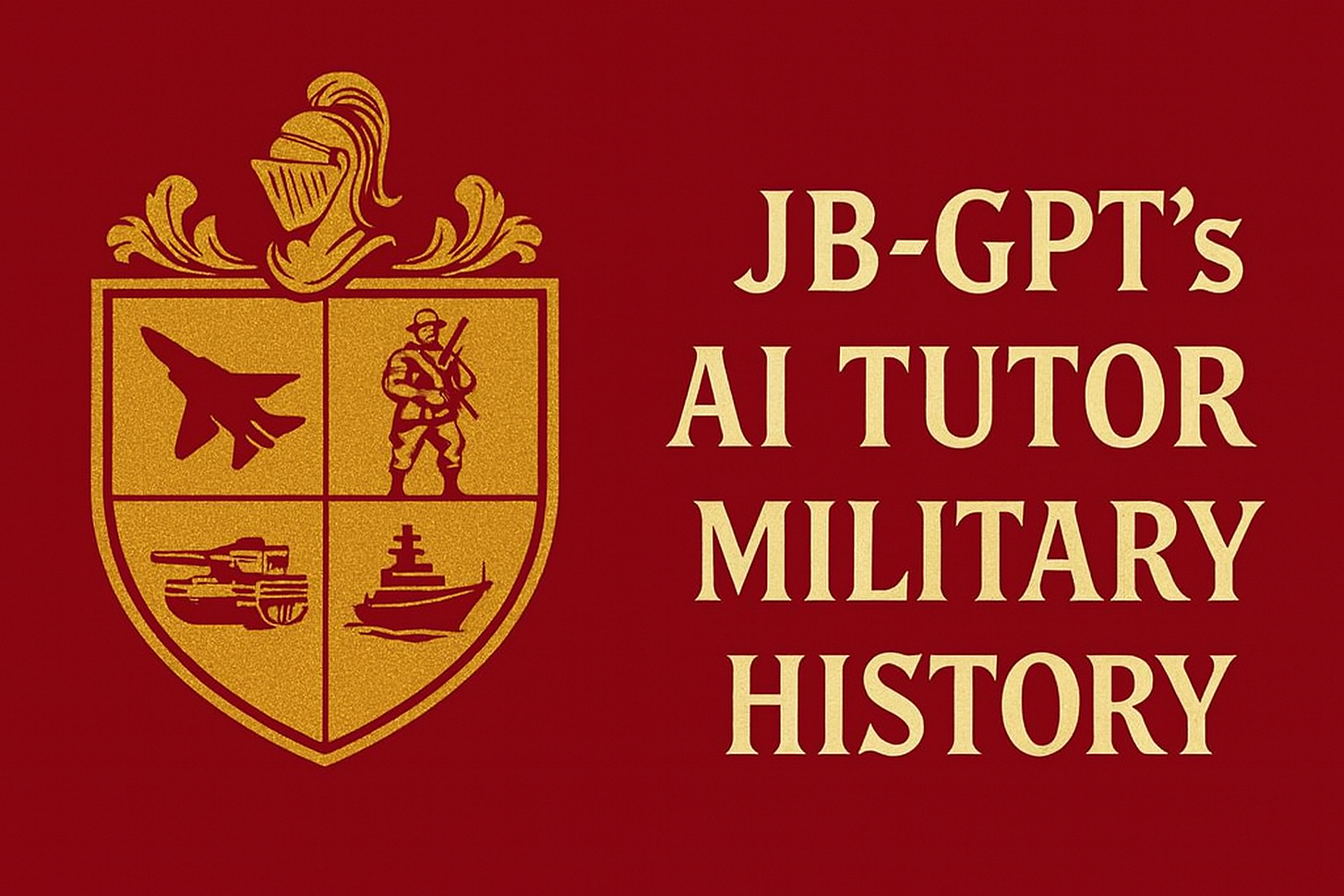AIT 2025-02..1939: BLITZKRIEG INTEGRATES GROUND AND AIR POWER—AP-13: JB-GPT's AI TUTOR
In 1939, Germany launched World War II with a radical new approach: Blitzkrieg—a combined-arms doctrine that fused fast-moving mechanized ground forces with concentrated tactical air power.
Copy and paste everything below this line into the AI of your choice. Fill in or delete where indicated.
============================================
AI INSTRUCTIONS
Preferred use references from: https://www.jb-gpt-prompts.com/jb-gpts-military-references
If additional references are used, they must be drawn from reputable and scholarly sources. These may include academic publications, books from established historians, official government documents, respected think tanks, and recognized academic institutions such as leading universities.
For follow-up question:
Provide 5 (or change number) numbered key points (40–60 words each), with author, book title, and chapter.
Add a separate Harvard-style bibliography.
Suggest 3 more follow-up questions.
Use clear language—no specialist jargon.
Follow-Up Questions (Delete those you don't use, or create your own e.g,, expand on key point four).
01. How did Blitzkrieg’s reliance on air-ground coordination redefine operational tempo and shock in modern warfare?
02. In what ways did the limitations of Blitzkrieg in Britain and the Soviet Union reveal the doctrine’s dependence on ideal conditions?
03. Why did postwar NATO doctrines adopt elements of Blitzkrieg despite its eventual strategic shortcomings?
1939: BLITZKRIEG INTEGRATES GROUND AND AIR POWER.
Overview
In 1939, Germany launched World War II with a radical new approach: Blitzkrieg—a combined-arms doctrine that fused fast-moving mechanized ground forces with concentrated tactical air power. The Luftwaffe supported ground breakthroughs by neutralizing enemy strongpoints, logistics, and communication hubs, enabling panzer divisions to penetrate deep into enemy territory. This method bypassed traditional trench warfare by creating operational shock and disruption. German success in Poland and France demonstrated the decisive impact of close air support, air interdiction, and command mobility. Though effective early on, Blitzkrieg’s dependency on air superiority and coordination revealed vulnerabilities as the war progressed—especially in the Soviet Union and during Allied counteroffensives.
Glossary
• Blitzkrieg — German for "lightning war," a WWII tactic emphasizing speed, surprise, and close air-ground coordination.
• Luftwaffe — Nazi Germany’s air force; central to Blitzkrieg doctrine through rapid tactical bombing.
• Stuka (Ju 87) — Dive-bomber used for pinpoint attacks during Blitzkrieg; known for psychological effects.
• Close Air Support (CAS) — Air missions supporting ground troops by striking nearby enemy forces.
• Air Interdiction — Operations to disrupt or destroy enemy forces before they reach the front.
• Panzer Divisions — German armored formations driving rapid ground offensives.
• Kesselschlacht — “Cauldron battle”; tactic involving encirclement using air and mobile ground forces.
• Command and Control (C2) — The coordination system enabling synchronized air-ground operations.
• Operational Shock — Overwhelming enemy decision-making through tempo and disruption.
• Fall Gelb (Case Yellow) — German 1940 campaign against France using Blitzkrieg principles.
15 Key Points
Blitzkrieg Origins
Blitzkrieg evolved from German interwar studies and WWI lessons. It emphasized mobility, mechanization, and joint force coordination to avoid attrition warfare and gain swift victory.Poland 1939: Operational Debut
Germany invaded Poland with air-ground synchronization. Stukas destroyed logistics nodes while panzers bypassed resistance, defeating Poland in 36 days.Air-Ground Synchronization
Blitzkrieg demanded seamless air-ground communication. Forward air controllers directed strikes, enabling precise support that amplified ground maneuver success.Case Yellow and the Ardennes Breakthrough
In May 1940, Germany bypassed French defenses via the Ardennes. Air attacks on infrastructure enabled fast ground advances, trapping Allied forces at Dunkirk.The Stuka’s Role
Ju 87 dive-bombers were vital for precision and psychological warfare. Sirens demoralized defenders, while accurate bombing neutralized hardened positions.Command Mobility and Radio Use
German forces used radios for real-time decisions. This gave them a coordination edge over Allies, who still relied on slower communication methods.Air Interdiction Strategy
Luftwaffe bombers targeted bridges and railways ahead of panzers, isolating enemy units and preventing reinforcements—key to Blitzkrieg's speed.Fall of France: A Blitzkrieg Victory
France fell in six weeks. Air-ground synergy, surprise, and maneuver outpaced Allied defense plans centered around static fortifications like the Maginot Line.Limitations in Britain and Russia
Without air superiority, Blitzkrieg faltered. The Luftwaffe’s failure in Britain and extended lines in Russia exposed the strategy’s limitations.Doctrine vs. Sustainability
Blitzkrieg's speed masked logistics problems. Overreliance on short campaigns led to failures when drawn-out warfare or resilient opponents emerged.Allied Adaptation and Countermeasures
Allies improved air support coordination and learned to isolate German spearheads. Operations in North Africa and Normandy reflected evolved tactics.Legacy and Modern Influence
Postwar doctrines, like NATO’s AirLand Battle, inherited Blitzkrieg’s emphasis on speed, deep strikes, and joint air-ground efforts.Shock and Dislocation Effects
Blitzkrieg aimed to paralyze enemy responses. Operational shock was achieved through surprise, tempo, and attacking command systems.Vertical Envelopment Concept
German doctrine included air-landing troops behind lines. While limited in WWII, this concept inspired later airmobile warfare developments.Doctrine and Myth
Blitzkrieg became romanticized as invincible. In reality, it relied on ideal conditions and struggled when those failed—particularly in prolonged campaigns.
Bibliography
Biddle, T.D. (2002) Rhetoric and Reality in Air Warfare: The Evolution of British and American Ideas about Strategic Bombing, 1914–1945. Princeton: Princeton University Press.
Bosworth, R.J.B. and Maiolo, J.A. (eds.) (2015) The Cambridge History of the Second World War, Vol. 2: Politics and Ideology. Cambridge: Cambridge University Press.
Boyne, W.J. (2001) Air Power: The Men, the Machines, and the Myths. New York: HarperCollins.
Corum, J.S. (2022) Bloody April 1917: The Birth of Modern Air Power. Oxford: Osprey Publishing.
O’Brien, P.P. (2015) How the War Was Won: Air–Sea Power and Allied Victory in World War II. Cambridge: Cambridge University Press.



